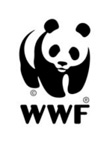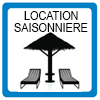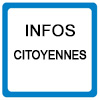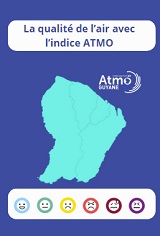Blada.com
mercredi 21 janvier
Boîtes aux lettres
Courrier des lecteurs
Petites annonces
Emploi / Formation
Covoiturage
Infos citoyennes
Infos citoyennes
25/11/19
Orpaillage illégal en Guyane : des chiffres inquiétants
 Le Parc Amazonien vient de lancer une nouvelle alerte sur le chiffre record de 145 sites miniers illégaux sur son territoire, le troisième bilan le plus élevé depuis 2008. A la veille de la première conférence annuelle pour la préservation de la biodiversité amazonienne des Guyanes (Guyane française, Guyana, Suriname, Amapà brésilien), le WWF France appelle les gouvernements concernés à une réelle ambition transfrontalière pour lutter contre ce fléau environnemental, social et sanitaire.
Le Parc Amazonien vient de lancer une nouvelle alerte sur le chiffre record de 145 sites miniers illégaux sur son territoire, le troisième bilan le plus élevé depuis 2008. A la veille de la première conférence annuelle pour la préservation de la biodiversité amazonienne des Guyanes (Guyane française, Guyana, Suriname, Amapà brésilien), le WWF France appelle les gouvernements concernés à une réelle ambition transfrontalière pour lutter contre ce fléau environnemental, social et sanitaire.
L’orpaillage illégal est aujourd’hui le principal vecteur de déforestation et de contamination des zones de vie et des espaces naturels du Plateau des Guyanes. A l’échelle de la Guyane seulement et jusqu’en 2015, le WWF France estime que les orpailleurs illégaux ont détruit plus de 12 000 Ha de forêt et pollué plus de 1800 km de cours d’eau à cause du mercure . Utilisé pour amalgamer l’or, ce métal lourd nuit gravement à la santé humaine : il s’accumule le long des chaînes alimentaires aquatiques atteignant des concentrations particulièrement importantes dans la chair des poissons carnivores dont se nourrissent les communautés autochtones.
Même le Parc Amazonien, qui constitue la plus grande aire protégée française et européenne avec près de 3 millions d’hectares de forêts à forte biodiversité, n’est pas épargné par le fléau de l’orpaillage illégal. Le dernier recensement fait état de 145 sites miniers illégaux dont 75% se situent dans la zone du fleuve Maroni, zone frontalière avec le Suriname, où la coopération transfrontalière demeure embryonnaire. Les témoignages recueillis dans le cadre des missions de terrain du WWF France ont montré une forte recrudescence des flux logistiques liés à l’orpaillage illégal dans cette zone, avec un fort sentiment d’insécurité au sein des communautés autochtones.
“A quelques semaines de l’année 2020, annoncée comme l’année charnière pour la protection de la nature, le niveau de protection du Parc Amazonien, la plus grande aire protégée française et européenne, doit être l’emblème de l’effectivité des politiques françaises de protection de la biodiversité, en métropole comme en Outre-mer. A ce stade, le niveau d’impact très élevé de l’orpaillage illégal en Guyane montre un profond décalage entre les ambitions annoncées par le président de la République et les réalités de terrain”.
Laurent Kelle, responsable du bureau du WWF France en Guyane
Face à ce constat alarmant, au-delà de la nécessité d’avoir des moyens adaptés à l’ampleur des défis liés à l’orpaillage illégal, le WWF France appelle notamment à :
- Décliner de façon opérationnelle la coopération frontalière avec le Suriname, dans le cadre d’un accord spécifique de lutte contre l’exploitation aurifère illégale;
- Relancer la dynamique de coopération avec le Brésil, dans le cadre de l’accord franco-brésilien de lutte contre l’exploitation aurifère illégale ratifié depuis 2013, permettant des missions conjointes et une coopération judiciaire accrue;
- Encourager l’application au Suriname et au Guyana de la convention de Minamata, visant l’élimination de l’utilisation du mercure, et dont la 3ème COP se déroule actuellement en Suisse.
Pour être crédible et entendue lors de la Conférence mondiale sur la biodiversité qui aura lieu en Chine en 2020, la France doit être en mesure de démontrer qu’elle agit concrètement à domicile et s’attaque aux principales menaces pour la nature, telles que l’orpaillage illégal.
The Amazonian Park has just launched a new alert on the record figure of 145 illegal mining sites on its territory, the third highest assessment since 2008. On the eve of the first annual conference for the preservation of Amazonian biodiversity in Guyana (Guyana French, Guyana, Suriname, Brazilian Amapà), WWF France calls the governments concerned to a real cross-border ambition to fight against this environmental, social and sanitary scourge.
Illegal gold panning is today the main vector of deforestation and contamination of the living areas and natural areas of the Guiana Shield. At the scale of Guyana only and until 2015, WWF France estimates that illegal gold miners have destroyed more than 12 000 ha of forest and polluted more than 1800 km of rivers because of mercury. Used to amalgamate gold, this heavy metal is a serious threat to human health: it accumulates along aquatic food chains reaching particularly high levels in the flesh of carnivorous fish that feed indigenous communities.
Even the Amazonian Park, which is the largest French and European protected area with nearly 3 million hectares of forests with high biodiversity, is not spared by the scourge of illegal gold panning. The latest census records 145 illegal mining sites, 75% of which are in the Maroni River area, a border area with Suriname, where cross-border cooperation remains embryonic. Testimonies collected during the WWF France field missions showed a sharp increase in logistical flows related to illegal gold panning in this area, with a strong feeling of insecurity in the indigenous communities.
"A few weeks before the year 2020, announced as the pivotal year for the protection of nature, the level of protection of the Amazon Park, the largest protected area in France and Europe, must be the emblem of the effectiveness of French policies to protect biodiversity, in metropolitan France as well as overseas. At this stage, the very high level of impact of illegal gold panning in Guyana shows a profound gap between the ambitions announced by the President of the Republic and the realities on the ground ".
Laurent Kelle, head of the WWF France office in French Guiana
Faced with this alarming observation, beyond the need to have means adapted to the extent of the challenges related to illegal gold panning, WWF France calls in particular to:
- Operatively decree border cooperation with Suriname as part of a specific agreement to combat illegal gold mining;
- Revive the momentum of cooperation with Brazil, as part of the Franco-Brazilian agreement against illegal gold mining ratified since 2013, allowing joint missions and increased judicial cooperation;
- Encourage the application in Suriname and Guyana of the Minamata Convention, aiming at the elimination of the use of mercury, whose 3rd COP is currently taking place in Switzerland.
To be credible and heard at the World Conference on Biodiversity to be held in China in 2020, France must be able to demonstrate that it is taking concrete action at home and tackling the main threats to nature, such as the illegal panning.
Raccourcis


passer une petite annonce

passer une annonce de covoiturage


passer une annonce d’emploi







associations, postez vos actualités

participez au courrier des lecteurs
La Guyane c’est ici
La qualité de l’Air avec
ATMO
Photothèque

Lancements 2022
Vol 259 Ariane 5




